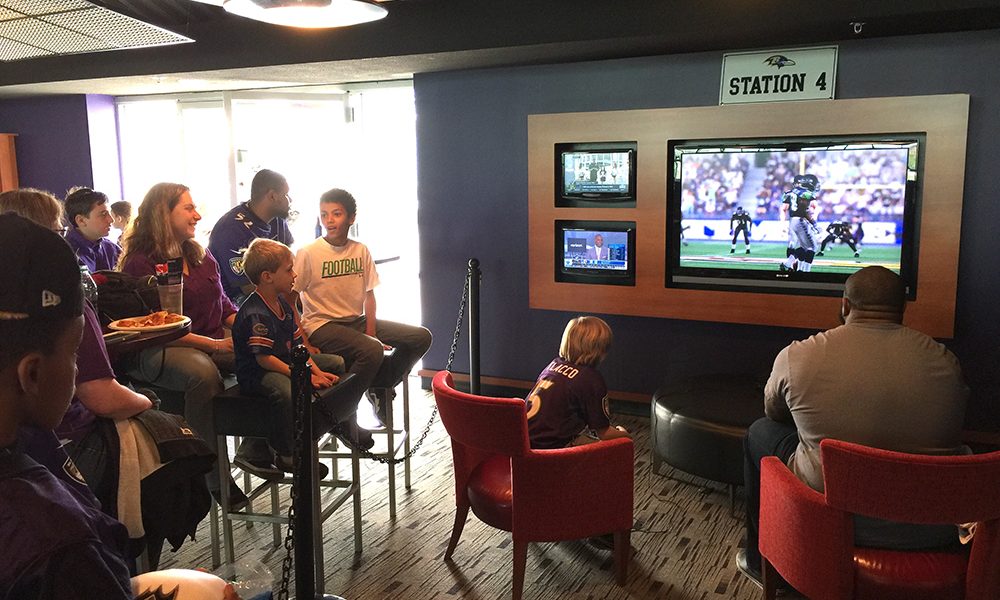News & Community
The Chatter: July 2016
Overheard at the Baltimore Ravens Flock Festival, Theosophical Society, and Kinetic Sculpture Race.
No Sweat
Russell Street
April 30, 2016
On M&T Bank Stadium’s club level, Rohan Peyser just won his age group in a Madden 16 Xbox tournament for the right to play against an actual Baltimore Raven. “Take it easy on him, shorty,” a stadium staffer calls out to the tow-headed, 58-pound fourth-grader as 335-pound nose tackle Brandon Williams picks up a joystick and lowers himself into the chair next to Peyser. But if the 10-year-old is intimidated, he doesn’t show it. Late in the first quarter, however, Williams—who has obviously played some Xbox himself—directs a Justin Forsett avatar into the end zone, sending the massive lineman into a celebratory dance.
In the second half, Williams hands his controller over to the team’s larger-than-life winged mascot, Poe, and Peyser stages a game-winning comeback. “He was good,” Peyser says of Williams. “Poe’s a rookie.”
The Xbox tourney is just part of today’s Flock Festival, a combination open house and draft day fan party. Joe Flacco and Steve Smith Sr. are on hand for autographs, while former players, including Duane Starks, announce the team’s fourth-round selections on the field. Along with a variety of kids’ activities, two Maryland Zoo ravens are here, as well as WBAL and 98 Rock, which are broadcasting live.
The highlight is probably the locker-room tour, where the purple home jerseys of Williams, Terrell Suggs, Elvis Dumervil, etc., hang in silence. There’s a fever and reverence in the air—not unlike that at a religious shrine, as fans pose for photos.
“I don’t think they’d be as excited on a Sunday,” says a security guard, calmly reminding visitors they are not allowed to sit on the players’ wooden stools. “The smell.”
Old New Age
North Charles Street
May 1, 2016
A passerby would likely miss the plain white door hidden a half-dozen steps above the renowned C. Grimaldi Gallery. The gold-stenciled lettering on the glass simply reads “The Theosophical Society” along with, curiously, a seven-digit phone number. You see, the small, nondoctrinaire, wisdom-seeking society, which promotes the study of philosophy, comparative religion, and metaphysics, has been here so long it predates area codes.
This afternoon, in fact, the organization—at its current location since 1929—celebrates the 100th anniversary of its chartering. Highlights today include a talk by Tim Boyd, the current president of the international Theosophical Society, and a presentation by archivist Janet Kerschner, who displays a 1939 photo of this very meeting room, sending members seated on folding chairs into convulsive laughter.
“Even the ferns are in the same place!”
The original Theosophical Society was formed in 1875 in New York City by Helena Blavatsky, a blue-eyed Russian spiritualist, Col. Henry Steel Olcott—an early American convert to Buddhism—and an Irish-born lawyer named William Quan Judge. In his address, Boyd credits the society for being among the first to introduce Eastern terms such as yoga, karma, and reincarnation into the Western lexicon. Kerschner traces theosophy’s Baltimore “boom” from the 1920s through the 1950s, which topped out at 73 members for the organization and included Sunday radio programs on WITH. Today, there are a little more than two dozen people—albeit an eclectic group of artists, retirees, ex-hippies, community organizers, and graduate students—on the chapter’s Listserv.
“I first came in 1971,” smiles Carl Hurwitz, a clinical psychologist with a gray pony tail. “We’ve been dying a slow death ever since that’s just taking a very long time.”
Moving Parts
Boston Street
May 7, 2016
A giant orange squid pedals downhill and splashes into the water at the Canton boat launch, drawing big cheers from the overflowing crowds gathered on the grassy banks. The squid is soon followed by an Alexander Calder-themed “Mobile Mobile” and another human-powered amphibious vehicle named “Wheel of (Mis)fortune.” But then a giant unicorn—built and driven by Oakland Mills high school students atop mountain bikes—capsizes.
“It’s cold, it’s cold,” a boy bellows, pulling himself onto the dock.
Meanwhile, a girl on the team smiles and breaks into a short backstroke.
“This is our second year,” says Oakland Mills teacher Skip Yarn, referring to the 18th annual Kinetic Sculpture Race, the have-to-see-it-to-believe-it event presented by the American Visionary Art Museum. “But it’s the first time we attempted the water entry. On a positive note, our steering on land has improved quite a bit.”
More than mere whimsical art farce, the “race” is also equal parts endurance contest and engineering challenge. The 15-mile trek from Federal Hill to Southeast Baltimore and back doesn’t just offer a spin in the Inner Harbor, but requires traversing sand and mud pits at Patterson Park.
“This weighs about 4,000 pounds when the nine-person crew is aboard,” says David Hess, captain of a sea and street-worthy vessel coined “The Golden Eyedra.” “It’s made from an ’87 Suzuki Samurai, so it’s also got four-wheel drive. The frightening part is going downhill at 35 miles per hour.”
The Arbutus Middle School entry this year is a four-wheeled sculpture named “Monsters of the Middle School Brain.” The enormous papier mâché “brain,” sitting above the team of bicyclists, depicts the daily horrors of cafeteria lunches and school bathrooms, as well as subjects like bullying.
“Up through fifth grade, everything is easy,” says sixth-grader Tressa Salava, explaining the sculpture’s origin and theme. “Then all of a sudden, there’s all this homework and kids towering over you.
“Middle school is pretty terrifying.”
